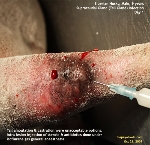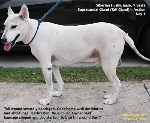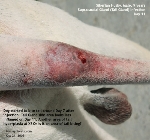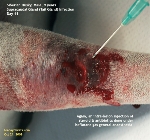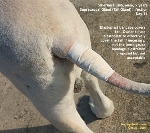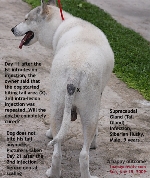History:
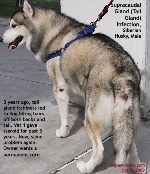 3
years ago, the Husky bit away all hairs of his backside and
tail due to tail gland hyperplasia. The disease was
controlled using steroids and antibiotics given by Vet 1.
Then, the dog started biting his tail gland area again, as
if possessed by spirits.
3
years ago, the Husky bit away all hairs of his backside and
tail due to tail gland hyperplasia. The disease was
controlled using steroids and antibiotics given by Vet 1.
Then, the dog started biting his tail gland area again, as
if possessed by spirits. Is there a complete cure for the tail gland disease in dogs? Various treatments are proposed but the owner needs a complete cure. Here are my thoughts on this subject.
Surgery:
1. Tail Gland Skin area excised. Removal of the hyperplastic skin area. This is quite a large area of over 3 cm x 3 cm leaving a big hole and a very tight area to stitch up. If there is infection due to stitch breakdown, the result will be worse for the dog. Will electrosurgery do the job? Maybe, if the area is small and seen during the first time. There is no guarantee. In this dog, there seems to be another nearby area with the same problem.
2. Tail amputation. Will this method definitely resolves the problem of tail biting? Most likely since the tail gland area is removed. But the owner did not want a tail-less Husky.
3. Castration. Since this disease happens mostly in male dogs, testosterone hormone may play a part. The Husky is already 9 years old and his testicles were checked and found to be normal by palpation. No pain, nor enlargement or irregular lumps. The owner did not wish to have him neutered. I can't guarantee that neutering will resolve this problem too.
Now, in some skin disease cases in female dogs, spaying resolves the problem based on anecdotal evidence. In such cases, hormonal imbalances could be the cause of skin inflammation and itchiness. But not all cases are resolved and some skin disease occurs due to hormonal deficiency after sterilisation. Therefore sterilisation may help but there is no guarantee. In this case, the owner decides not to have the dog neutered in case his temperament is changed and he become more inactive.
Medical Treatment
This Husky was given a second intra-lesion steroid. 14 days later, the owner said that the tail gland area had turned to a light pink colour and there was no problem so far. He schedules the dog for dental treatment.
 TOA
PAYOH VETS
TOA
PAYOH VETS
